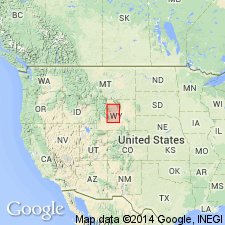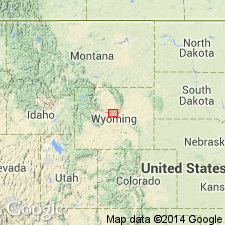
- Usage in publication:
-
- Lost Cabin formation
- Modifications:
-
- Named
- Dominant lithology:
-
- Shale
- Sandstone
- AAPG geologic province:
-
- Wind River basin
Summary:
Named as the upper stage of the Wind River formation, as a stage of the Wind River series, and as Lost Cabin formation for village of Lost Cabin, T4N, R90W, Fremont Co, WY in the Wind River basin. Type area is east of Lost Cabin along Alkali Creek and on the divide between Alkali and Poison Creeks. Name applied to rocks of the LAMBDOTHERIUM zone. This zone contains banded red and blue "beds" and overlying "bluish shales and gray and yellow sandstones." Conformably overlies Lysite stage of Wind River stage of Wind River series or Lysite formation (new). Conformably underlies Bridger formation. Of Eocene age. [Term Wind River group not used.]
Source: GNU records (USGS DDS-6; Denver GNULEX).

- Usage in publication:
-
- Lost Cabin member*
- Modifications:
-
- Revised
- Overview
- AAPG geologic province:
-
- Wind River basin
Summary:
Reduced in stratigraphic rank and assigned to the Wind River formation as its upper member. Consists of gray and grayish-green siltstone and claystone, and yellowish-brown to orange sandstone. The sandstones were deposited as sheets and channels; some of them are conglomeratic; they become coarser-grained and more conglomeratic near the mountains. Variegated beds abundant. Member has the following characteristics: 1) the conglomerates consist of debris from pre-Cambrian and Cambrian rocks; 2) most predominant red colors are shades of violet; 3) variegated beds grade laterally into gray and gray-green beds; 4) sandstones contain abundant black mica and some feldspar grains. Should be used as a name along the southern margin of Big Horn Mountains. Gradationally overlies Lysite member (revised) of Wind River formation. Also overlaps Paleozoic and Mesozoic rocks of Big Horn Mountains. Is at least 400 ft thick. Fossil mammals found in member listed. Stratigraphic table. Geologic map. Mapped in Fremont and Natrona Cos, WY, T38N to 40N, R88W to 94W, in the Wind River basin. Is of early Eocene age. Considered older than some unnamed middle Eocene beds.
Source: GNU records (USGS DDS-6; Denver GNULEX).
For more information, please contact Nancy Stamm, Geologic Names Committee Secretary.
Asterisk (*) indicates published by U.S. Geological Survey authors.
"No current usage" (†) implies that a name has been abandoned or has fallen into disuse. Former usage and, if known, replacement name given in parentheses ( ).
Slash (/) indicates name conflicts with nomenclatural guidelines (CSN, 1933; ACSN, 1961, 1970; NACSN, 1983, 2005, 2021). May be explained within brackets ([ ]).

